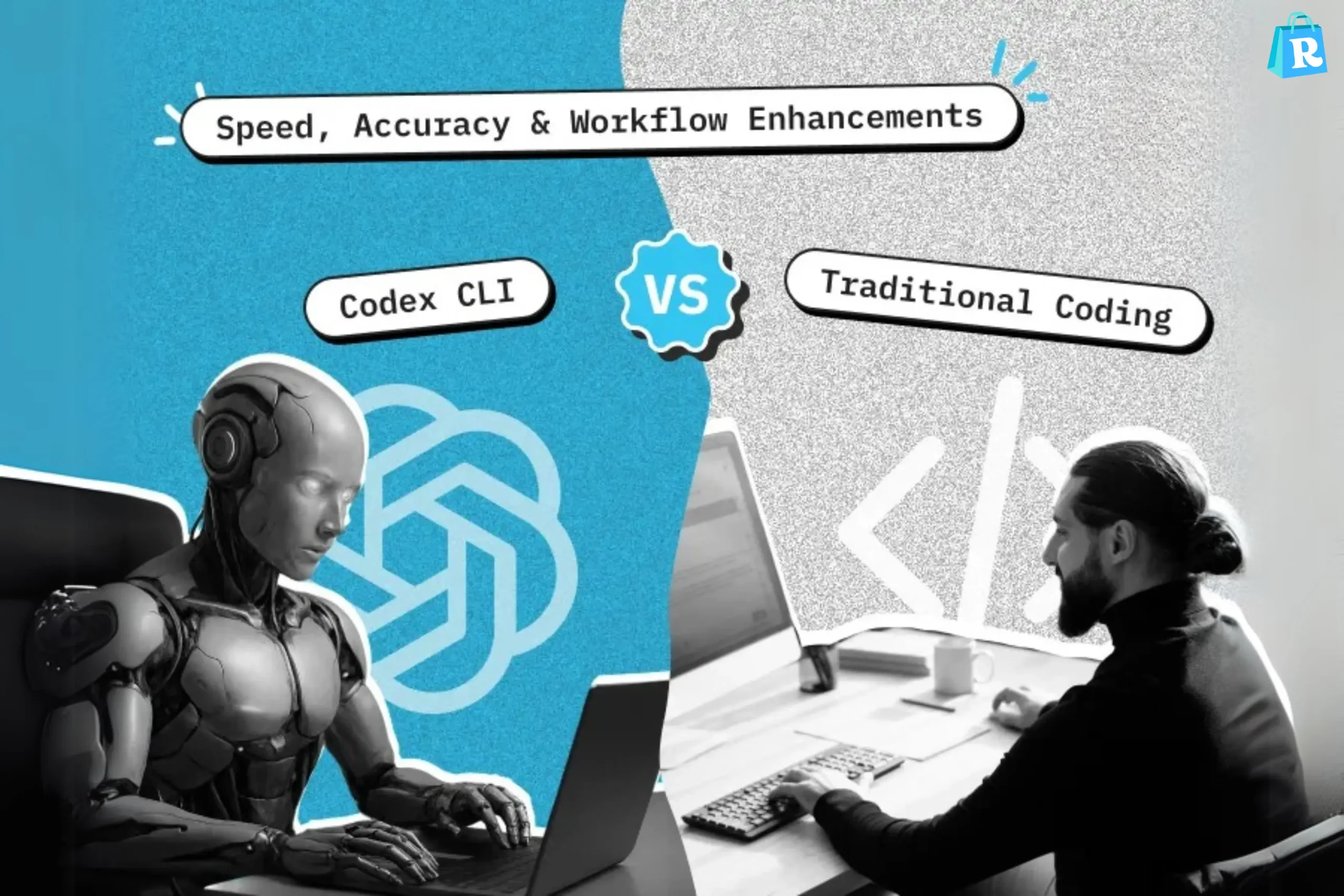Imagine describing a software feature in plain English and watching it turn into working code within seconds. This isn’t a glimpse into the distant future—it’s what OpenAI Codex offers today. As the world of software development continues to evolve at breakneck speed, Codex introduces a radical new approach: programming through conversation. This innovation brings programming capabilities to non-developers and supercharges productivity for experienced coders, making it a technology worth exploring deeply.
In this blog post, we explore OpenAI Codex in contrast to traditional programming tools. By comparing the capabilities, use cases, and underlying mechanisms of Codex with the established programming landscape, we uncover the fundamental shifts Codex introduces. From development speed to learning curve, from flexibility to integration, Codex Vs conventional programming tools is more than a debate—it’s a reflection of the direction in which software engineering is headed. Stay with us as we unpack this transformation in detail.
What is OpenAI Codex?
OpenAI Codex is an AI system built on GPT-3 that translates natural language into code. Developed by OpenAI, it understands more than a dozen programming languages and can generate code snippets, functions, or entire applications from a human-written prompt. Whether it’s building a webpage or querying a database, Codex processes human commands and converts them into syntactically accurate, logical programming instructions. Unlike traditional programming tools, Codex acts as a partner in the development process, minimizing the need for manual coding from scratch.
The AI’s training involves billions of lines of public code data sourced from GitHub, giving it a strong foundation to understand real-world programming tasks. It supports major languages like Python, JavaScript, TypeScript, Go, and Ruby, among others. Integrated into tools like GitHub Copilot, Codex brings its capabilities right into development environments such as Visual Studio Code, thereby enhancing the coding workflow.
How Traditional Programming Tools Work
Traditional programming tools include integrated development environments (IDEs), code editors, compilers, and debuggers. These tools require developers to manually write, test, and debug their code, relying on strong foundational knowledge in programming languages and logic. Some tools offer features like syntax highlighting, auto-completion, and error checking to streamline the development process, but the user still has to do the heavy lifting.

For example, in Visual Studio or IntelliJ IDEA, a developer writes code line by line, checks for errors, and manually tests it to ensure proper functionality. While highly efficient for experienced developers, these tools present a steep learning curve for beginners and are time-intensive for repetitive tasks.
Ease of Use: Codex Vs Traditional Tools
Codex offers a drastically simplified interface for interacting with code. By allowing users to issue natural language prompts, it reduces the need to remember exact syntax or structures. For instance, a user can type “create a function that returns the factorial of a number,” and Codex will generate the appropriate function in Python or another selected language.
Traditional programming tools, on the other hand, demand a precise understanding of syntax and logic. Even small typos or logical errors can cause failures. While many IDEs provide debugging tools, the user must interpret and resolve the issue manually. Codex streamlines this by suggesting corrections in real time, effectively cutting down the troubleshooting process.
Speed and Productivity Comparison
One of the most compelling features of Codex is its potential to significantly accelerate development. It enables rapid prototyping by generating code instantly from simple instructions. Developers can skip boilerplate code and focus on fine-tuning the logic and architecture.
In contrast, traditional programming tools may slow down the process, especially for complex or repetitive tasks. Although these tools have evolved to include some productivity-enhancing features like live previews and version control integration, they still require considerable manual intervention. Codex introduces a new layer of automation that helps developers write more code in less time.
Accuracy and Reliability
While Codex can generate code that works in most scenarios, it is not without limitations. The code produced may sometimes include inefficiencies or subtle bugs that require manual review. Users must still possess enough programming knowledge to verify and test the AI-generated code to ensure it aligns with their project requirements.
Traditional tools, although slower, allow for precise control over every aspect of the code. Developers using these tools are directly involved in each decision, leading to more intentional and often more reliable software design. Codex, in its current form, is best viewed as a supplement to—not a replacement for—traditional coding methods.
Learning Curve for Beginners
For beginners, Codex is revolutionary. It bridges the gap between programming knowledge and execution by allowing them to experiment with code without mastering complex syntax. New learners can focus on understanding logic and flow rather than memorizing keywords or structures.
Traditional programming tools are less forgiving. Newcomers often struggle with setup, syntax, and debugging. While many educational platforms and IDEs have become more user-friendly, the learning curve remains steep. Codex reduces this barrier significantly, making programming more accessible to a wider audience.
Integration Capabilities
Codex is most powerful when integrated into environments like GitHub Copilot, where it serves as a coding assistant within existing workflows. It complements traditional tools by enhancing auto-completion, offering suggestions, and even writing test cases. This hybrid approach means Codex doesn’t necessarily replace traditional tools but enhances them.
Traditional tools often require plugins and manual configuration to extend their capabilities. While powerful and flexible, they are not inherently intelligent. Codex, through integrations, adds a layer of contextual understanding that traditional tools lack, bridging the gap between static tooling and dynamic code generation.
Use Cases and Practical Applications
Codex shines in scenarios that require rapid development, prototyping, or automation of repetitive tasks. It’s particularly useful in writing unit tests, creating simple apps, and translating business logic into code. For non-developers, it enables basic task automation without hiring a full development team.
Traditional tools are ideal for large-scale, complex projects where control, accuracy, and performance are crucial. Applications involving intricate backend systems, high concurrency, or tight optimization requirements are better handled through conventional tools, where developers have complete command over the codebase.
Security and Ethical Concerns
As with any AI-based tool, Codex raises questions about security and responsible use. Since it is trained on public code repositories, there’s a risk of reproducing insecure coding practices or licensed code. Developers must be vigilant about code quality, attribution, and potential security risks.
Traditional tools do not pose these specific concerns. Since all code is written manually, there’s less chance of inadvertently copying proprietary logic or insecure functions. However, the responsibility for security remains with the developer in both scenarios.
Comparison Table: Codex Vs Traditional Programming Tools
| Feature | OpenAI Codex | Traditional Programming Tools |
|---|---|---|
| Input Method | Natural language prompts | Manual coding |
| Speed | Fast prototyping and generation | Slower, especially for boilerplate tasks |
| Learning Curve | Low for beginners | High for new learners |
| Flexibility | Limited to supported languages/tasks | Broad flexibility and control |
| Integration | Integrated via extensions (e.g., Copilot) | Built-in and extensible through plugins |
| Accuracy | Varies, requires review | High with developer expertise |
| Security Concerns | Potential for inherited vulnerabilities | Manual review minimizes risk |
| Use Case Suitability | Ideal for automation and prototyping | Ideal for large, complex systems |
| Code Understanding | Based on context prediction | Based on developer logic |
| Debugging Tools | Suggests fixes inline | Manual but precise debugging tools |
Key Features of OpenAI Codex
Codex accepts natural language inputs and converts them into multiple programming languages, making it a versatile tool for developers of all skill levels. It operates within popular IDEs through extensions, allowing seamless workflow integration. Its context-awareness enables it to generate relevant suggestions and debug code snippets in real time. Codex also assists in writing documentation, testing scripts, and handling API interactions. It is continually updated to support broader languages and frameworks, ensuring adaptability to emerging technologies.
5 Pros and Cons of Codex Vs Traditional Tools
Pros:
Codex enables faster development by auto-generating functional code from simple instructions.
It significantly reduces the learning barrier for beginners entering software development.
Codex integrates well with modern IDEs, enhancing existing toolsets.
It is ideal for rapid prototyping and automating repetitive coding tasks.
Codex can assist in documentation and test case generation, saving time.
Cons:
Generated code may lack optimization or contain subtle bugs.
It can occasionally suggest insecure coding patterns.
Limited understanding of project-wide context in large codebases.
Less control over code structure compared to manual development.
Dependence on Codex could limit deeper learning of programming concepts.
FAQs About OpenAI Codex
1. Can OpenAI Codex completely replace human developers?
No, Codex is a powerful assistant but not a full replacement. Developers still need to verify, optimize, and contextualize the generated code.
2. What programming languages does Codex support?
Codex supports over a dozen languages including Python, JavaScript, TypeScript, Ruby, Go, and more.
3. How is Codex integrated into coding workflows?
It is most commonly used through GitHub Copilot, which integrates into IDEs like Visual Studio Code to offer inline suggestions.
4. Is Codex suitable for learning programming?
Yes, it helps beginners understand coding logic and structure by translating natural language into real code examples.
5. What are the risks of using Codex-generated code?
There may be risks related to code quality, security, and licensing, so human review is always necessary.
Conclusion
OpenAI Codex is redefining the boundaries of software development by making programming more accessible and efficient. Through its natural language interface and AI-driven code generation, it empowers users to build functional code faster and with less effort. For beginners, it lowers the entry barrier, and for experienced developers, it enhances productivity and focus.
However, Codex is not without limitations. While it excels in speed and accessibility, traditional programming tools maintain their value through precision, flexibility, and control. Codex is best viewed as a complement to conventional development tools—a hybrid approach that combines human ingenuity with machine intelligence. As AI continues to evolve, the collaboration between Codex and traditional methods may well become the new standard in coding.




